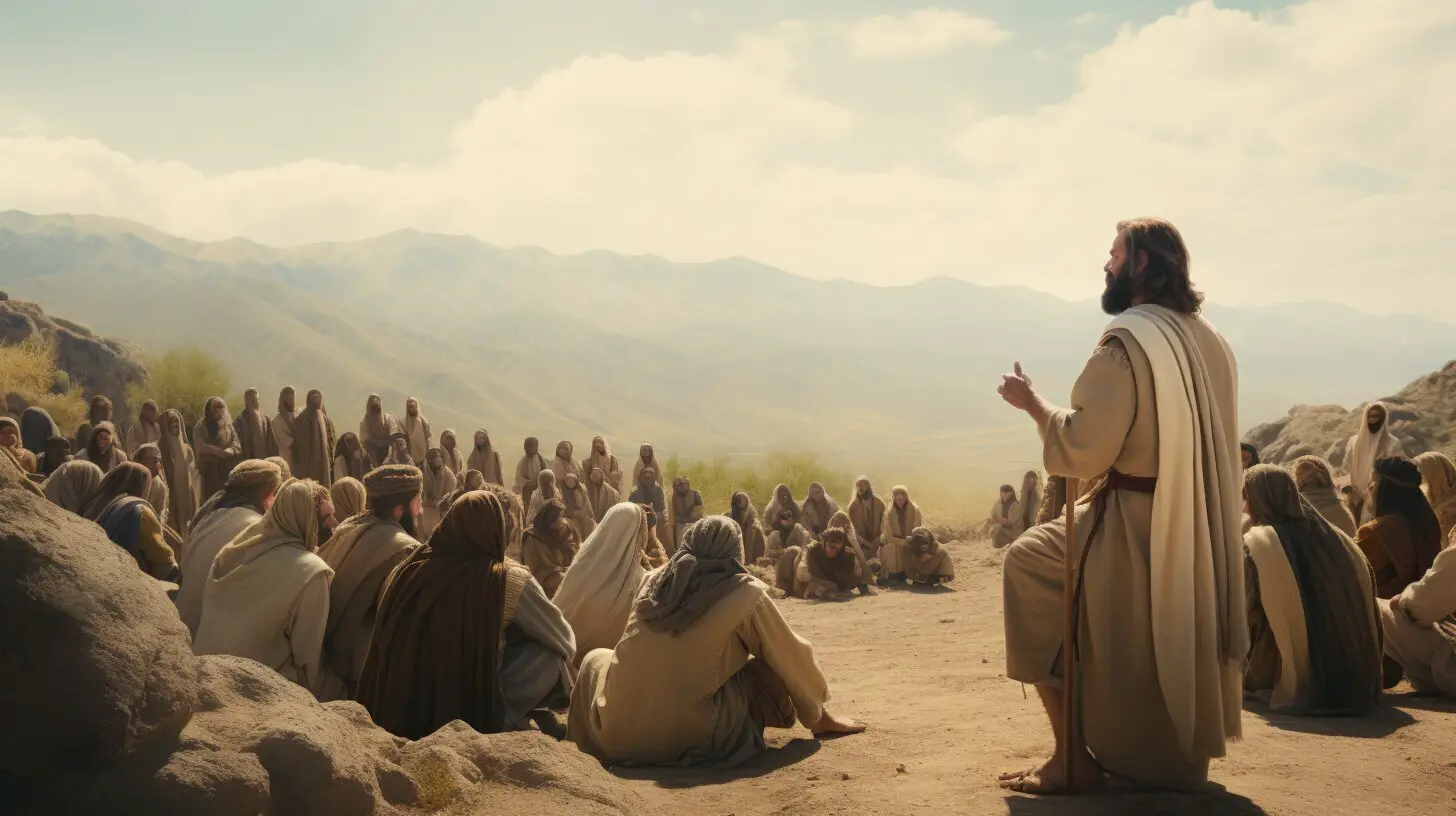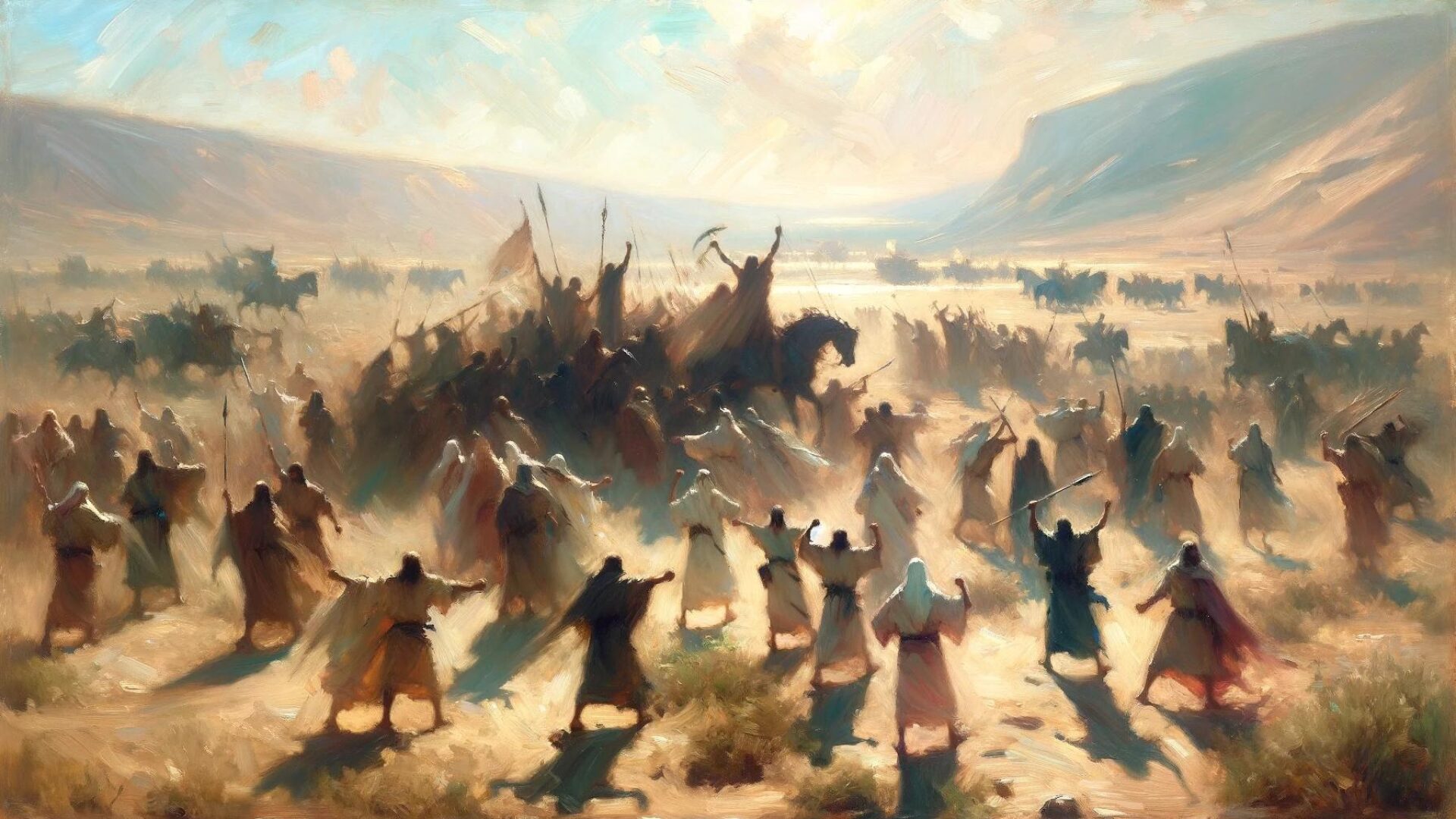The Sermon on the Mount and the Sermon on the Plain are two of the most significant biblical sermons recorded in the Gospels of Matthew and Luke, respectively. These sermons are considered among the most essential teachings of Jesus Christ, providing powerful insights into Christian theology and spirituality.
While both sermons share many similarities, there are also key differences that are essential to understanding the message and impact of each teaching. In this article, we’ll explore the differences between the Sermon on the Mount and the Sermon on the Plain, highlighting the unique insights and messages contained in each.
The Sermon on the Mount
The Sermon on the Mount is one of the most well-known and influential sermons from the teachings of Jesus in the Bible. It is recorded in the Gospel of Matthew, chapters 5-7, and is often referred to as the “greatest sermon ever preached.” This sermon was delivered by Jesus to a large crowd of both disciples and curious onlookers on a mountainside near the Sea of Galilee.
The Sermon on the Mount contains a number of important teachings and messages from Jesus that have had a profound impact on Christian theology. Among the themes explored in this sermon are the Beatitudes, which outline the qualities of a blessed life, and the importance of loving one’s enemies and forgiving those who have wronged you. Jesus also discusses a number of other topics in this sermon, including prayer, fasting, and the danger of materialism.
The Sermon on the Mount has been the subject of extensive interpretation and analysis throughout Christian history. Many have looked to this sermon as a guide for how to live a virtuous and ethical life, while others have focused on its broader message of love, peace, and forgiveness. The teachings of Jesus in this sermon continue to inspire and challenge Christians around the world today.
The Sermon on the Plain
The Sermon on the Plain was delivered by Jesus Christ to a large crowd of people on a level place, as recorded in the Gospel of Luke. This sermon is often compared to the Sermon on the Mount, which is found in the Gospel of Matthew. While there are many similarities between the two sermons, there are also key differences in location, audience, and content.
Location
Unlike the Sermon on the Mount, which was delivered on a mountain, the Sermon on the Plain was delivered on a level place. This may seem like a minor difference, but it is significant because it reflects the different settings in which the two sermons were delivered.
| Sermon on the Mount | Sermon on the Plain |
|---|---|
| Delivered on a mountain (Matthew 5:1) | Delivered on a level place (Luke 6:17) |
Audience
The audience for the Sermon on the Plain was different from the audience for the Sermon on the Mount. While the Sermon on the Mount was delivered to the disciples of Jesus, the Sermon on the Plain was delivered to a large crowd of people, including both disciples and non-disciples.
| Sermon on the Mount | Sermon on the Plain |
|---|---|
| Delivered to the disciples of Jesus (Matthew 5:1) | Delivered to a large crowd of people, including disciples and non-disciples (Luke 6:17) |
Content
While both sermons contain teachings of Jesus, there are differences in the content of the Sermon on the Mount and the Sermon on the Plain. The Sermon on the Mount includes the Beatitudes, while the Sermon on the Plain includes the Woes. The Sermon on the Mount emphasizes humility and poverty of spirit, while the Sermon on the Plain emphasizes justice and social equality.
| Sermon on the Mount | Sermon on the Plain |
|---|---|
| Includes the Beatitudes (Matthew 5:3-12) | Includes the Woes (Luke 6:24-26) |
| Emphasizes humility and poverty of spirit | Emphasizes justice and social equality |
“Blessed are you who are poor, for yours is the kingdom of God. But woe to you who are rich, for you have already received your comfort.” – Luke 6:20, 24
Overall, the Sermon on the Plain is an important biblical sermon that complements the Sermon on the Mount by providing a different perspective on the teachings of Jesus. By understanding the differences between the two sermons, we can gain a deeper appreciation for the range and depth of Jesus’ message of love, justice, and mercy.
Key Differences in Location
The Sermon on the Mount and the Sermon on the Plain are two of the most well-known biblical sermons recorded in the Gospels of Matthew and Luke, respectively. One of the key differences between these two sermons is their location.
| Sermon on the Mount | Sermon on the Plain |
|---|---|
| Delivered on a mountaintop near the Sea of Galilee | Delivered on a level field in the presence of a large crowd |
| Setting provided a natural amphitheater that allowed Jesus’ voice to carry to the crowds | Setting provided a more intimate environment for Jesus to connect with his audience on a personal level |
The Sermon on the Mount took place on a mountaintop near the Sea of Galilee, while the Sermon on the Plain was delivered on a level field in the presence of a large crowd. The setting of the Sermon on the Mount allowed Jesus’ voice to carry to the crowds gathered below, creating a natural amphitheater that amplified the message. In contrast, the Sermon on the Plain provided a more intimate environment for Jesus to connect with his audience on a personal level.
These differences in location likely influenced the delivery and message of Jesus in each sermon. The Sermon on the Mount’s location may have allowed for a more forceful and commanding presentation, while the Sermon on the Plain’s setting may have enabled Jesus to connect with his audience in a more conversational and relatable manner.
Differences in Audience
One of the key differences between the Sermon on the Mount and the Sermon on the Plain is the audience that was present for each sermon. The Sermon on the Mount, as recorded in the Gospel of Matthew, was delivered to a large crowd that had gathered to hear Jesus speak. The audience was primarily made up of Jesus’ disciples, but it also included many other people who had come to see him.
In contrast, the Sermon on the Plain, as recorded in the Gospel of Luke, was delivered to a smaller group of people. The passage states that Jesus “came down with them and stood on a level place” in the presence of his disciples and a “great multitude of people”. While the Sermon on the Plain also had a large audience, it was not as expansive as the one present for the Sermon on the Mount.
This difference in audience composition may have influenced the teachings of Jesus in each setting. The Sermon on the Mount may have been more focused on spreading a broad message to a diverse crowd, whereas the Sermon on the Plain may have been more tailored to the needs and concerns of a smaller group.
Contrasting Themes and Teachings
The Sermon on the Mount and the Sermon on the Plain share many similarities in terms of their overarching message of righteousness and spiritual transformation. However, a closer examination of the content reveals significant differences in tone and emphasis between the two sermons.
Beatitudes
One of the most notable differences between the two sermons is the presence of the Beatitudes in the Sermon on the Mount (Matthew) and not in the Sermon on the Plain (Luke). The Beatitudes are a series of blessed statements that outline the characteristics and rewards of those who follow Christ.
“Blessed are the poor in spirit, for theirs is the kingdom of heaven.”
The absence of this passage in the Sermon on the Plain shifts the focus towards action and behavior, rather than inner character traits. Instead of offering words of blessing, Luke records Jesus’ admonitions to “love your enemies” and “do good to those who hate you.”
Kinship with the Marginalized
Another key difference is the way in which Jesus addresses the marginalized in society. In the Sermon on the Mount, Jesus reiterates the importance of justice and mercy, stating that “blessed are those who hunger and thirst for righteousness.” He extends this message to include the poor in spirit and those who mourn.
In contrast, the Sermon on the Plain emphasizes the physical needs of the marginalized. Jesus urges his followers to provide for those who are hungry, thirsty, and in need of clothing and shelter. He also calls for compassion and generosity towards those who are often despised and rejected by society.
Religious Practices
Jesus’ teachings on religious practices also differ between the two sermons. In the Sermon on the Mount, Jesus critiques the religious leaders of his day for their hypocritical and performative piety. He encourages his disciples to pray, give, and fast in secret, rather than seeking recognition from others.
Meanwhile, the Sermon on the Plain emphasizes the importance of forgiveness and non-judgment towards others. Jesus warns against the dangers of hypocrisy and encourages his followers to cultivate a spirit of compassion and grace.
Overall, while both the Sermon on the Mount and the Sermon on the Plain offer valuable teachings on Christian living, their unique themes and messages provide important nuances in understanding the teachings of Jesus.
Comparison of Impact and Interpretation
The Sermon on the Mount and the Sermon on the Plain have had a profound impact on Christian theology and continue to be studied and interpreted by scholars and believers alike. Despite their many similarities, the key differences between these two sermons have influenced their interpretation and application throughout history.
Interpretation of the Sermon on the Mount
The Sermon on the Mount, as recorded in the Gospel of Matthew, is perhaps the most well-known and widely studied of Jesus’ teachings. Its emphasis on love, forgiveness, and humility has been central to Christian teachings for centuries, and its impact can be seen in everything from the Beatitudes to the Lord’s Prayer.
However, the interpretation of the Sermon on the Mount has varied widely throughout history. Some have seen these teachings as a call to social justice and political reform, while others view them as a purely spiritual message. Some have emphasized the pacifist message of turning the other cheek, while others have used the Sermon on the Mount to justify violent resistance.
Interpretation of the Sermon on the Plain
The Sermon on the Plain, as recorded in the Gospel of Luke, is less well-known than the Sermon on the Mount but has still had a significant impact on Christian thought. Its focus on the poor, the oppressed, and the disenfranchised has been especially influential, with many interpreting these teachings as a call to social justice.
Like the Sermon on the Mount, the interpretation of the Sermon on the Plain has been varied and complex. Some have seen these teachings as a message of hope for the marginalized, while others have emphasized their spiritual significance. Some have interpreted the Sermon on the Plain as a call to action, while others have emphasized the importance of prayer and reflection.
Comparing Impact
Despite their differences, both the Sermon on the Mount and the Sermon on the Plain have had a profound impact on Christian theology and practice. Their teachings on love, forgiveness, and humility have been central to Christian thought for centuries, influencing everything from individual faith to social and political movements.
Both sermons have also been the subject of intense study and interpretation, with scholars and believers alike seeking to understand their messages and apply them to their lives. While their interpretation has varied widely, the overall impact of these sermons on Christian thought and practice cannot be denied.
Conclusion
Overall, the Sermon on the Mount and the Sermon on the Plain offer unique insights into the teachings of Jesus and their impact on Christian theology. It is important to understand the key differences between these sermons, including their locations, audiences, and themes.
The Sermon on the Mount, as recorded in the Gospel of Matthew, contains some of the most well-known teachings of Jesus, including the Beatitudes and the Lord’s Prayer. Its location on a mountainside has been interpreted as a symbol for Jesus’ authority as a teacher.
The Sermon on the Plain, recorded in the Gospel of Luke, offers a different perspective, with Jesus delivering his message from a level place. This sermon focuses more on social justice issues and practical applications of faith.
Why These Sermons Matter
Both sermons have had a significant impact on Christian thought and practice throughout history. The teachings found in these sermons have influenced many aspects of Christian theology, including ethics, morality, and spirituality.
It is important to note that there are differing interpretations of the messages found in these sermons. Some view them as a call to individual piety and righteousness, while others see them as a call to social and political action.
Further Exploration
To fully understand the significance of the Sermon on the Mount and the Sermon on the Plain, it is important to explore the teachings within the context of their respective Gospels. Further study of the Gospel of Matthew and the Gospel of Luke can provide deeper insights into the messages of these sermons and their impact on Christian theology.
Overall, the Sermon on the Mount and the Sermon on the Plain offer valuable teachings for Christians seeking guidance and inspiration in their spiritual journeys.
FAQ
Q: What is the Sermon on the Mount?
A: The Sermon on the Mount refers to a famous sermon delivered by Jesus in the Gospel of Matthew. It contains various teachings and moral instructions that are considered foundational to Christian beliefs.
Q: What is the Sermon on the Plain?
A: The Sermon on the Plain is a sermon given by Jesus in the Gospel of Luke. It shares similarities with the Sermon on the Mount but also has distinct differences in terms of location, audience, and content.
Q: What are the key differences between the Sermon on the Mount and the Sermon on the Plain?
A: The key differences between the Sermon on the Mount and the Sermon on the Plain include the locations where they were delivered, the audience present for each sermon, and the specific teachings and themes emphasized by Jesus in each sermon.
Q: Why are the Sermon on the Mount and the Sermon on the Plain significant?
A: The Sermon on the Mount and the Sermon on the Plain hold great significance in Christian theology as they contain teachings that are central to the faith. They provide moral guidance and serve as important examples of Jesus’ teachings.
Q: How did the locations of the sermons influence their messages?
A: The locations of the Sermon on the Mount and the Sermon on the Plain played a role in shaping the delivery and message of Jesus. The specific settings provided different contexts for the teachings, resulting in distinct emphases and themes.
Q: Who was present for the Sermon on the Mount and the Sermon on the Plain?
A: The Sermon on the Mount was delivered to a large crowd of disciples and followers, while the Sermon on the Plain was addressed to Jesus’ disciples and a multitude of people from various regions.
Q: How do the themes and teachings in the sermons differ?
A: While the Sermon on the Mount and the Sermon on the Plain share common themes, such as the Beatitudes, they also have unique teachings. The content in each sermon highlights different aspects of Jesus’ message and provides distinct insights into his teachings.
Q: How have the sermons been interpreted throughout history?
A: The Sermon on the Mount and the Sermon on the Plain have had a significant impact on Christian theology and have been interpreted in various ways throughout history. Different theological perspectives have shaped the understanding and application of their teachings.
Q: Why is it important to understand the differences between these sermons?
A: Understanding the differences between the Sermon on the Mount and the Sermon on the Plain allows for a deeper appreciation of Jesus’ teachings and the nuances of biblical interpretation. It helps to enrich one’s understanding of Christian theology and its application in daily life.





